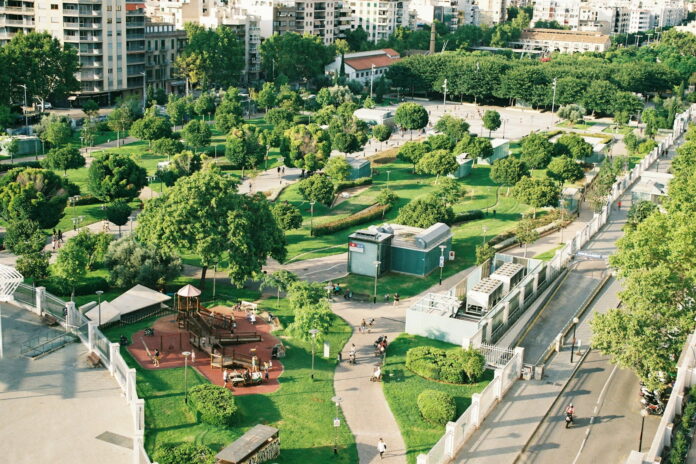Urban environments have long been viewed as concrete jungles, far removed from the natural world. However, the concept of urban green corridors is revolutionizing the way we think about integrating nature into city planning. These green pathways are essential for promoting biodiversity, connecting habitats, and providing ecological benefits and recreational spaces for city inhabitants.
Establishing Urban Green Corridors
The establishment of urban green corridors begins with a strategic plan that prioritizes the identification of key areas within the urban landscape that can serve as potential corridors. This involves mapping out existing green spaces like parks, gardens, and natural habitats, and then identifying where gaps occur that could be bridged to create continuous green pathways. Planners must consider the natural flow of the city, looking for underutilized spaces such as abandoned rail lines, riverbanks, and utility easements that could be transformed into vibrant green corridors.
Once potential corridors are identified, the next step involves community engagement and collaboration. Urban green corridors thrive when they are supported by local residents, businesses, and government entities. Public consultations and workshops help gather input and build consensus around the design and functionality of these green spaces. This collaborative approach ensures that the corridors serve both ecological and social purposes, providing recreational opportunities and improving the overall quality of life for urban dwellers.
Securing funding and support is crucial for the implementation of urban green corridors. This can come from a mix of public and private sources, including government grants, environmental NGOs, and corporate sponsorships. With adequate resources, cities can invest in the appropriate landscaping, native plantings, and maintenance required to establish thriving green corridors. These greenways then become integral parts of the urban infrastructure, contributing to the city’s sustainability goals and enhancing the well-being of its residents.
Enhancing Connectivity for Biodiversity
Urban green corridors serve as vital lifelines for wildlife, allowing species to move freely and safely across urban landscapes. Enhancing biodiversity connectivity requires the careful planning of these corridors to ensure they align with wildlife movement patterns. By integrating features such as wildlife crossings and native vegetation, corridors can become conducive to the needs of different species, from pollinators to small mammals.
To effectively enhance biodiversity, corridors must also be designed with ecological integrity in mind. This means creating a diverse range of habitats within the corridors, including woodlands, wetlands, and meadows. Such diversity ensures that a variety of species can find suitable niches within the urban ecosystem. It is also important to manage invasive species and to ensure that the plantings within these corridors support native flora and fauna, thereby contributing to the overall ecological health of the city.
Monitoring and research are critical components in enhancing connectivity for biodiversity. Data collected on species presence, abundance, and movement within urban green corridors can inform adaptive management strategies, ensuring that the corridors continue to meet the needs of wildlife. Citizen science initiatives can also play a role in monitoring efforts, engaging the public in conservation and fostering a deeper connection between urban residents and their natural surroundings.
Implementing Green Infrastructure Solutions
Green infrastructure is a key element in the development of urban green corridors, offering a multifunctional approach that combines ecological services with urban needs. Implementing green infrastructure involves integrating natural processes into the built environment, such as using permeable surfaces for pathways to reduce stormwater runoff and mitigate flooding. Green roofs and walls can also be incorporated within the corridors, providing additional habitat and improving air quality.
Innovative design is at the heart of green infrastructure solutions. Urban planners and landscape architects must create spaces that are not only aesthetically pleasing but also serve multiple functions. For example, bioswales and rain gardens within green corridors can filter pollutants from stormwater while providing attractive landscape features. Smart planning can also ensure that these greenways serve as heat island mitigation strategies, offering cool refuges in the midst of urban heat.
The long-term success of green infrastructure in urban green corridors depends on maintenance and stewardship. Cities must allocate resources for the upkeep of these spaces, and local community groups can be instrumental in their care. Educational programs that inform citizens about the benefits of green infrastructure can mobilize community support and encourage the adoption of similar practices on private properties. By scaling up green infrastructure across the urban landscape, cities can enhance the resilience and sustainability of their communities.
Urban green corridors are a testament to our ability to harmonize urban development with the natural environment. By establishing these lush pathways, enhancing connectivity for biodiversity, and implementing innovative green infrastructure solutions, we can create cities that are not only more sustainable and resilient but also more pleasant and healthful places to live. These strategies require collaboration, careful planning, and a commitment to stewardship, but the rewards are manifold. As urban populations continue to grow, the importance of linking life through green corridors will only increase, urging us to reimagine our concrete jungles as thriving ecosystems for both humans and wildlife alike.
